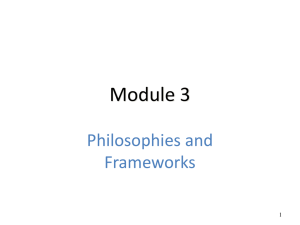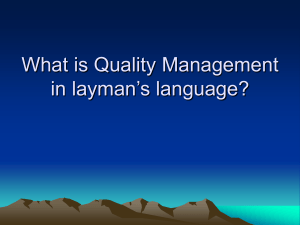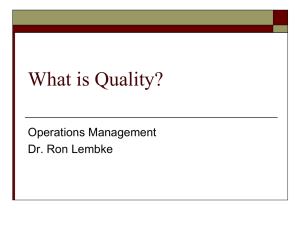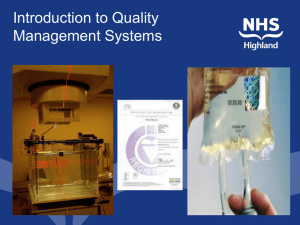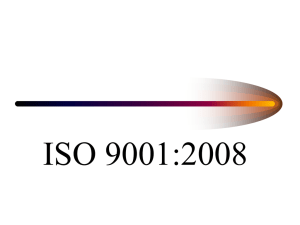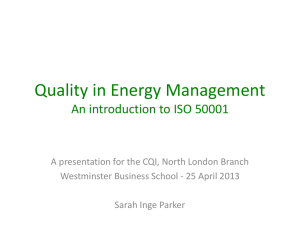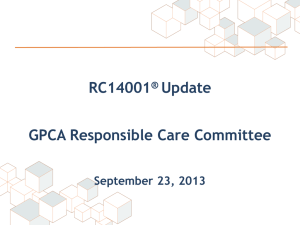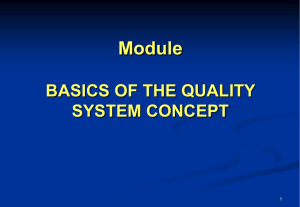Software Project Management
advertisement
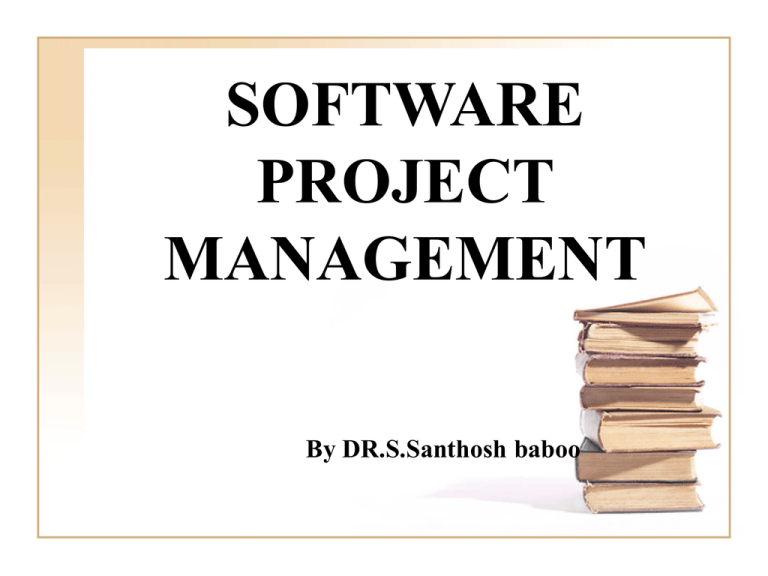
SOFTWARE PROJECT MANAGEMENT By DR.S.Santhosh baboo PROJECT: The dictionary definition put a clear emphasis on the project being a planned activity The characteristic which distinguish project as Non routine task are involved Planning is required Specific objectives are to be met Work is carried out for someone other than yourself Work involves several specialisms Work is carried out in several phases The project is large The resources are available for use on the project are constrained MANAGEMENT: Management involves following activities: Planning –deciding what to be done Organizing-making arrangement Staffing-selecting right people for right job Directing-giving instruction monitoring-checking on progress Controlling-taking action to remedy holdups Innovating-coming up with new solution Representing-liasing with clients, users, developers, suppliers and stakeholders MANAGING SOFTWARE PRODUCT: Worldwide, some half a million project managers execute about a million software projects each year, producing software worth $600 billion. Many of these projects fail to fulfill customers‘ quality expectations or fail to deliver the software within budget and on schedule. One analysis suggests that1about one-third of projects have cost and schedule overruns of more than 125%. Why do so many software projects fail? Although there are many reasons, one of the most important is improper management of the project. PROCESS AND MANAGEMENT CONCEPTS: A software project has two main activity dimensions: engineering and project management. The engineering dimension deals with building the system and focuses on issues such as how to design, test, code, and so on. The project management dimension deals with properly planning and controlling the engineering activities to meet project goals for cost, schedule, and quality. PROJECT MANAGEMENT PROCESS: For a project team to successfully execute a project, it must perform hundreds of tasks, many of them interdependent. Effectively managing this process is extremely important for success. At software companies, the set of activities executed by a project manager is specified in the project management process. It is fairly standard, having three main stages: Project planning Project execution Project closure PROBLEM WITH SOFTWARE PROJECT: Poor estimation and plain Lack of quality of standard and measurement Lack of guidance about making organizational decisions Lack of techniques to make process visible Poor roll definition STAKEHOLDERS: people who are having a stake or interest in the project. It is important that they be identified as possible, be cause you need to communicate channel with right from the start. REQUIRED SPECIFICATION: Functional requirement Quality requirement Resource requirement STEP WISE PROJECT PLANNING: 0.Select Project 1.Identify scope and objectives 2.Identify project infrastructure 3.Analyse project characteristics 4.Identify products and activities 5.Estimate effort for each activity 6.Identify activity risks 7.Allocate resources 8.Review plan 9.Execute plan STEP 0: select the project Step 1: Identify the project scope and objectives. identify the object and measurement of effectiveness in meeting them. establish a project authority identify stake holders Step 2: Identify the project infrastructure Establish relationship between project and strategic planning Identify installation standards and procedure Identify the project team organization Step 3: Analyses the project characteristic Distinguish the project as either objective or product driven Analyses other project characteristic Identify the high level project risk Take into account user requirements concerning implementation Select general life cycle approach Review overall resource estimation Step 4: identify the product and the activities Identify and describe project products Document the generic product flows Recognize the product instance Product deal activities network Modify deal to take into account need for stages and check point Step 5: estimate effort for each activities Carryout the bottom up estimation Revise plan to create controllable activities Step 6: identify the activity risk Identify and describe quantify activity based risks Plan risk reduction and contingency measures where appropriate Adjust plans and estimates to take account of risks Step 7: Allocate resources Identify and allocate resources Revise plans and estimates to take account of resource constraints Step 8: Review/publicize plan Review quality aspects of project plan Document plans and obtain agreement Step 9/10: Execute plan/lower level of planning This may require the reiteration of the planning process at a lower level. SELECT THE PROJECT: Deciding whether the project can be taken up or not Technical,Organizational and Financial Feasibility is considered Programme Management Group of projects managed in a coordinated way to gain benefits. DIFFERENT FORM OF PROGRAMME: Strategic Programmes Business cycle programmes Research and development programmes PROGRAM MANAGEMENT AND PROJECT EVALUATION : Program management Managing the allocation of resources within programs Strategic program management Creating a program Aids to programme management Beneficial management Technical assessment Evaluation of individual projects Cast-benefit analysis Cash flow forecasting Cost benefit evaluation techniques Risk evaluation STRATEGIC PROGRAMMES: Several projects implement single strategy] Two Organizations Unified Payroll The Projects are coordinated and done according to the strategy BUSINESS CYCLE PROGRAMMES: Specific budget for the projects If one project is delayed, staff from other team can be used and resources also can be used RESEARCH AND DEVELOPMENT PROGRAMMES: New innovative ideas to develop new products High risk if successful result is good CREATING A PROGRAMME: The Programme Mandate The Programme Brief The Vision Statement The Blue Print THE PROGRAMME MANDATE: Formal document describing New services programme should deliver How organization will be improved by new services Programme director provides initial leadership THE PROGRAMME BRIEF: Information sufficient to decide about project(vision statement) Estimates cost,performance and risk BLUE PRINT: Organizational structure(staffs and skills) Resources Data and information requirements IDENTIFY PROJECT SCOPE AND OBJECTIVES: Scope and Objectives of the project are Constraints Meet requirements Cost control Identify stake holders and their interest Communication IDENTIFY PROJECT INFRASTRUCTURE: Project should fit in existing infrastructure Project manager should have full control over the project Project Manager should be aware of Project planning and control SELECTION OF AN APPROPRIATE PROJECT APPROACH: Choosing technologies Technical plan contents list Choice of process models Structure versus speed of delivery The waterfall model Spiral model Software prototyping Incremental delivery Dynamic system development Extreme programming Managing iterative processes Selecting a most appropriate process model PROJECT ANALYSIS: Outcome of analysis will be selection of most appropriate methodologies and technologies Methodologies(Unified Software Development Process (USDP), Structured system analysis and design methods (SSADM)) Technologies(Environments , Software etc) STEPS IN PROJECT ANALYSIS: Identify project as either objective driven or product driven Analyses Project Characteristics Data driven or Process driven General tool or application specific Specific tools available(Graphics etc) Hardware and software environment Entertaining games or servicing CHOICE OF PROCESS MODELS: The activities can be organized in different ways known as models(Process Models) The various models are Waterfall Model V Process Model Spiral Model WATER FALL MODEL: Feasibility study User Requirements Analysis System design Program design Coding Testing Operation V-PROCESS MODEL: User acceptance Feasibility study User acceptance User requirements System design System testing Program design Code Program testing SOFTWARE EFFORT ESTIMATION: The definition of successful project is delivering the project on correct time within the budget at good quality Hence estimation such as Lines of Code,Number of months have to be done Estimates are carried out at various stages of the project BASIS FOR SOFTWARE ESTIMATION: Need of historical data(past projects) Measure of work(Lines of code) Complexity(varies with the project) EFFORT ESTIMATION TECHNIQUES: Function point method Empirical model method FUNCTION POINT METHOD: The measures are collected by means of various functions such as Number of user inputs Number of user outputs Number of user inquiries Number of files Number of external interfaces EMPIRICAL MODEL METHOD: Cocomo Model(COnstructive COst MOdel) This model deals with sizing information such as number of screens, number of reports etc. The Productivity rate is determined from which the effort in months is calculated RISK MANAGEMENT Risk Categories of risk A framework for dealing with risk Risk identification risk assessment Risk planning Risk management Evaluating risk to scheduling Critical chain concepts conclusion RISK MANAGEMENT: Risk is an uncertain event or condition that if occurs has positive or negative effect on a project’s objectives Key elements of risk are 1. It relates to the future 2. It involves cause and effect (Cost, Staff) CATEGORIES OF RISK: Project Risk(Objectives) Business Risk(Cost) Social Technological Risk(Staff,Technology,Tasks) RISK DEALING: Risk Identification Risk Analysis and Prioritization Risk Planning Risk Monitoring RISK IDENTIFICATION: Use of Checklists and Brainstorming Checklists refer to the number of risks that occur regularly in development of project Brainstorming uses stakeholders to identify risks and find a solution to the problems CHECKLISTS: Risk 1.Personnel shortfalls 2.Unrealistic time and cost estimates 3.Late changes to requirements 4. Technical problem 5.Developing wrong software functions BRAINSTORMING: The stakeholders together identify the risks and identify possible solutions to overcome the risk. The main stakeholders are considered for risk identification RISK ANALYSIS AND PRIORITIZATION: The risk is potentially endless hence the risk exposure should be calculated by the following formula Risk Exposure=Potential damage*Probability of occurrence The risk exposure can be calculated for all sort of risks in the checklist RISK PLANNING: The risks are identified and prioritized, then decision should be taken to deal with the risk The choices are 1.Risk Acceptance 2.Risk Avoidance 3.Risk Reduction and Mitigation 4.Risk Transfer RISK PLANNING: Risk Acceptance Some risks can be ignored, some risks have to be solved Risk Avoidance The risks should be avoided before itself(Staff,Technology etc) Risk Reduction Take precautions to reduce the risk Risk Transfer The project can be transferred to other organization who are experienced RISK MONITORING: The steps for risk reduction should be implemented and monitored in this stage The Project Manager should monitor the risks carefully by means of documents and register it. The evaluation of risk management should be done to see how the risk is reduced. RESOURCE ALLOCATION: Nature of resources Identifying resource requirements Scheduling resources Creating a critical path Counting the cost Being specific Publishing the resource scheduling Cost schedules The scheduling sequence conclusion RESOURCE ALLOCATION: The resource is an item or staff required to complete a project. The various categories of resources are 1.Labour 2.Equipment 3.Materials 4.Space 5.Services 6.Time 7.Money IDENTIFYING RESOURCE REQUIREMENTS: Resource allocation plan to know about the demand Each activity is considered to identify the resources allocated SCHEDULING RESOURCES: The resources are scheduled according to the priority.The resource which is needed immediately is allocated first The resource scheduling is done according to the modules The resource availability is seen and then only scheduled. 8.MONITORING AND CONTROL: Creating the framework Collecting a data Visualizing process Cost monitoring Earned value analysis Prioritizing monitoring Getting a project back to target Change control conclusion MONITORING AND MANAGE CONTROL: The progress of the project is monitored as it is under the way after resource allocation The control is established through the project control cycle The steps in the cycle are Start Publish initial plan Gather project information Compare progress vs targets If satisfactory continue else revise and start from step 3 If project completed continue else goto step 3 End project and review Give document conclusions CATEGORIES OF REPORTING: Oral Formal Regular(Weekly Meetings) Oral Formal AdHoc(End stage Revies) Written Formal Regular(Jobsheets,Progress Reports) Written Formal AdHoc(Change Reports) GUIDELINES: • Risk Management • Cost Management • Resource Management MANAGING CONTRACT: The ISO12207 approach to the acquisition and supply of software The supply process Types of contract Stages in contract placement Typical terms of contract Contract management Acceptance conclusion MANAGING PEOPLE AND ORGANIZING TEAMS: Understanding behavior Organization behavior Selecting a right person for right job Instruction in best methods Motivation Working in groups Becoming a team Decision making Leadership Organizational structures RECRUITMENT PROCESS: Create a job specification(Requirements) Create a job holder profile Obtain Applicants(Advertisement) Examine CV`s Conduct of Interviews Other Procedures(Medical Examination) ORGANIZING TEAMS: The stages of development for forming a team Forming(Know each other,stick on to rules) Storming(Method of operation to avoid conflicts) Norming(Group entity settled and no conflicts) Performing(Tasks emphasized) Adjourning(Group starts their work) SOFTWARE QUALITY: The place of software quality in project planning Importance of software quality Defining a software quality Practical software quality measure Product versus process quality management External standards Techniques to help enhance software quality Quality plan conclusion SOFTWARE QUALITY: Quality is defined as “How well the project performs as we have planned” Quality is concerned at various stages of planning and execution SOFTWARE QUALITY MEASURES: Reliability Maintainability Extendibility SOFTWARE QUALITY MANAGEMENT SYSTEM: – Quality Assurance • Through this process an org. establishes procedures and standards that lead to the development of high quality software – Quality Planning • Involves selection of appropriate procedures and standards for a project that will deliver quality software • Sets the direction for the quality process- without clear spec. regarding desired quality of the product – Quality Control • Ensures that selected procedures are followed throughput the project. MEASURING SOFTWARE QUALITY: The first step towards measurement is to identify software metrics Metrics is defined as ‘a quantitative measure of the degree to which a system, component or processes a given attribute’ –i.e., It involves collection of data over a period of time that gives a measure of performance Three reasons for which you need to measure a software system: To determine the quality of the product and development process in relation to expected standards. To predict the qualities that the product will exhibit in future in relation to expected standards To improve the quality of the product and the process that produced it WHAT ARE SOFTWARE REVIEWS? WRITING THE SOFTWARE SPECIFICATION Everyone knew exactly what had to be done until someone wrote it down! OBJECTIVES OF REVIEWS: Uncover errors in any representation of software Verify that software meets its requirements software follows predefined standards software is developed in uniform manner Make projects more manageable Educate new team members HOW TO CARRY OUT REVIEWS: THE REVIEW TEAM producer review leader reviewer(s) recorder BASIC GUIDELINES (1) 3-6 people (typical) experienced senior technical staff representatives of team that created the document client representative team for next development phase software quality assurance group IEEE Standard for Software Reviews and Audits [IEEE 1028, 1988] BASIC GUIDELINES (2) Review leader should be SQA representative has the most to lose creator: eager to get approval (to start next job) client: can wait for acceptance testing Review leader distributes material Advance preparation of max. 2 hours before the meeting Duration: less than 2 hours RESULT OF A REVIEW: Decision about the product accept without further modification reject the work due to severe errors (review must be repeated) accept with minor modifications (that can be incorporated into the document by the producer) All participants have to sign-off shows participation responsibility shows their concurrence with the findings REVIEWER’S PREPARATION: be sure that you understand the context first, skim all the product material to understand location and format of the information next, read product material and annotate hardcopy pose your written comments as questions avoid issues of style inform the review leader if you can’t prepare CONDUCTING THE REVIEW Be prepared - evaluate product before review develop check list for each kind of work product review the product, not the producer keep your tone mild, ask questions instead of making accusations stick to the review agenda raise issues, don’t resolve them! limit discussions (do them off line!) avoid discussions of style - stick to technical correctness schedule reviews as project tasks (allocate resources) record and report all review results QUALITY MANAGEMENT SYSTEM • • • • • • • • Processes Standards Techniques Guidelines Templates Checklists Forms Document structure and Update Prcedure QUALITY MODEL ISO 9000 Model Software Engineering Institute Model ISO 9000 STANSARDS: ISO 9000 : model for qlty. assurance in design/development, production, installation and servicing ISO 9002 : model for qlty. assurance in production and installation ISO 9003 : model for qlty. assurance in final inspection and test ISO 9000 ISO (international Standards Organization): – Consortium established to formulate and foster standardization. ISO published its 9000 series of standards in 1987. What is ISO 9000 Certification? ISO 9000 certification: serves as a reference for contract between independent parties. The ISO 9000 standard: specifies guidelines for maintaining a quality system. ISO 9000 specifies: guidelines for repeatable and high quality product development. Also addresses organizational aspects responsibilities, reporting, procedures, processes, and resources for implementing quality management. ISO 9000 Certification An ISO certified organization can use the certificate for corporate advertisements cannot use the certificate to advertise products. ISO 9000 certifies organization's process not any product of the organization. An organization using ISO certificate for product advertisements: risks withdrawal of the certificate. Summary of ISO 9001 Requirements: Management responsibility(4.1): Management must have an effective quality policy. The responsibility and authority of all those whose work affects quality: must be defined and documented. Management responsibility: Responsibility of the quality system. independent of the development process, can work in an unbiased manner. The effectiveness of the quality system: must be periodically by audited. Quality system and contract reviews A quality system must be maintained and documented. Contract reviews (4.3): Before entering into a contract, an organization must review the contract ensure that it is understood, organization has the capability for carrying out its obligations. Design control: The design process must be properly controlled, this includes controlling coding also. A good configuration control system must be in place. Design inputs must be verified as adequate. Design must be verified. Design output must be of required quality. Design changes must be controlled. Document control: Proper procedures for document approval, issue and removal. Document changes must be controlled. use of some configuration management tools is necessary. Process Control: The development must be properly managed. Quality requirements must be identified in a quality plan. Inspection and Testing: In software terms this requires effective testing i.e., unit testing, integration testing and system testing. Test records must be maintained. Corrective Action: This is both about correcting errors when found, investigating why they occurred improving the process to prevent further occurrences. If an error reoccurs despite the quality system, the system needs improvement. Handling and Quality audits: Handling Deals with: storage, packing, and delivery of the software product. Quality Audits : quality system audit must be carried out to ensure its effectiveness. Salient features of ISO 9001 requirements: All documents concerned with the development of a software product should be properly managed, authorized, and controlled. Proper plans should be prepared progress against these plans should be monitored. Important documents independently checked and reviewed: for effectiveness and correctness. The product should be tested : against specification. Several organizational aspects: e.g., management reporting of the quality team. Shortcomings of ISO 9001 Certification: ISO 9000 requires a production process to be adhered to: but does not guarantee the process to be of high quality. Does not give any guideline for defining an appropriate process. Shortcomings of ISO 9001 Certification: ISO 9000 certification process not fool-proof no international accreditation agency exists. likely variations in the norms of awarding certificates: among different accreditation agencies and among the registrars. SEI Quality Process Initial Level Repeatable Level Defined Level Managed Level Optimizing Level SEI Capability Maturity Model: The SEI CMM classifies software development industries into: Five maturity levels. Stages are ordered so that improvements at one stage provide foundations for the next Based on the pioneering work of Philip Crosby SEI Capability Maturity Model: Optimizing (5) Managed (4) Defined (3) Repeatable (2) Initial (1) Level 1: (Initial) Organization operates without any formalized process or project plans An organization at this level is characterized by ad hoc and often chaotic activities. Level 1: (Initial) Software production processes are not defined, different engineers follow their own process development efforts become chaotic. The success of projects depend on individual efforts and heroics. Level 2: (Repeatable) Basic project management practices tracking cost, schedule, and functionality are followed. Size and cost estimation techniques function point analysis, COCOMO, etc. used. Production process is ad hoc not formally defined also not documented. Process used for different projects might vary between projects: earlier success on projects with similar applications can be repeated. Opportunity to repeat process exist when a company produces a family of products. Level 3: (Defined) The process though defined, process and product qualities are not measured. ISO 9001 aims at achieving this level. Management and development activities: defined and documented. Common organization-wide understanding of activities, roles, and responsibilities. Level 4: (Managed) Quantitative quality goals for products are set. Software process and product quality are measured: The measured values are used to control the product quality. Results of measurement used to evaluate project performance rather than improve process. Organization sets quantitative quality goals World-wide about 100 organizations assessed at this level. Level 5: (Optimizing) Statistics collected from process and product measurements are analyzed: continuous process improvement based on the measurements. Known types of defects are prevented from recurring by tuning the process lessons learned from specific projects incorporated into the process Identify best software engineering practices and innovations: tools, methods, or process are identified transferred throughout the organization World-wide about 50 organizations have been assessed at this level. Key Process Areas Each level is associated with a key process area (KPA) identifies where an organization at the previous level must focus to reach this level Level 2 KPAs Software project planning Size, cost, schedule. project monitoring Configuration management Subcontract management Level 3 KPAs Process definition and documentation Reviews Training program Level 4 KPAs Quantitative measurements Process management Level 5 KPAs Defect prevention Technology change management Process change management CONCLUSION Hence the stepwise planning is necessary to make the software project management successful


